PINAL COUNTY, Ariz.—If drugs aren’t stopped along the U.S.–Mexico border in Arizona’s remote desert, chances are, a large proportion will end up traveling through Pinal County on its way to Phoenix, a major trafficking hub.
Around 40 percent of illicit drugs enter the United States through Arizona, said Pinal County Sheriff Mark Lamb.
Hard narcotics—such as heroin, methamphetamines, and fentanyl—are usually hidden in vehicles and driven through one of Arizona’s seven ports of entry along its border, while marijuana has traditionally been backpacked through the desert between border crossings.
In the past few years, Mexican drug cartels have been flooding the United States with methamphetamines and fentanyl, driving the supply so hard and dropping the price so low that it pushes up addiction rates and the market then demands more drugs.
“Our demand is based on what the cartel’s pushing. The demand is what the cartels create in our society,” Lamb told The Epoch Times.
“So they go out into areas and they will give out meth at a reduced price, or free, to certain places. They love rural areas—hard-working, blue collar people that are, life has got its boot on their throats. They get into those communities, and then it trickles into the cities. And once they’re into the cities, it’s a lot easier.”
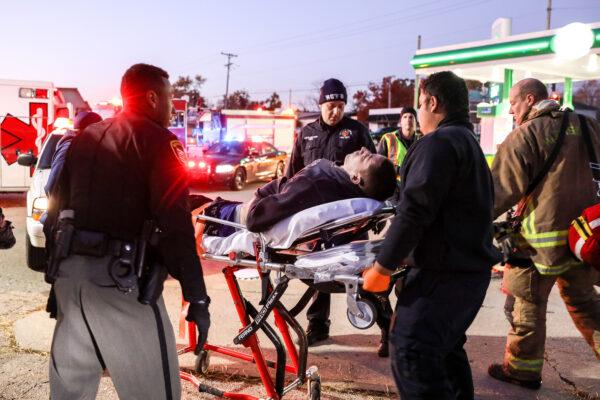
The increase is reflected in meth seizures at the border, especially at ports of entry. Border agents seized more than 82,000 pounds of meth along the whole southern border in fiscal year 2019, compared to less than 24,000 pounds in fiscal 2014.
“I would venture to say we’re not catching 20 percent,” Lamb said of the border seizures, based on his conversations with the Border Patrol drug unit. “It’s probably more around 10 percent.”
Inside the United States, Drug Enforcement Administration (DEA) seizures of meth more than doubled from about 50,000 pounds in fiscal 2017 to 112,000 pounds in fiscal 2019.
Lamb’s office in Pinal County seized 3,000 percent more meth in 2019 (153 pounds) than it did in 2018 (4.4 pounds).
It’s a billion-dollar business that will only change if the cartels’ bottom line takes a significant hit, Lamb said.
“Take Walmart, for example. Walmart has ... an accepted loss ratio that they'll accept, whether it’s through theft, damaged goods, stolen goods, whatever it may be. They’re not going to change their ways very much unless it exceeds that threshold,” he said.
“Well, the cartel’s no different. They’re a billion-dollar industry and they have their own threshold. Now I’ve heard it’s anywhere between 20 and 25 percent. We’ve never impacted that. I think I’ve heard of maybe once or twice where we’ve impacted it to where they changed the way they do things.”
Along with the increase in volume coming into the United States, the meth produced in the Mexican super labs is getting close to 100 percent in purity, according to the DEA.
Meth and fentanyl are both made in labs, making it easier and cheaper for cartels to produce year-round, without the land area and large staff needed for crop maintenance that heroin and cocaine require.
The number of deaths caused by psychostimulants (predominantly methamphetamines) increased by 37 percent from 2016 to 2017, according to the Centers for Disease Prevention and Control (CDC). More than 10,000 Americans died from an overdose involving psychostimulants in 2017, the CDC reported.
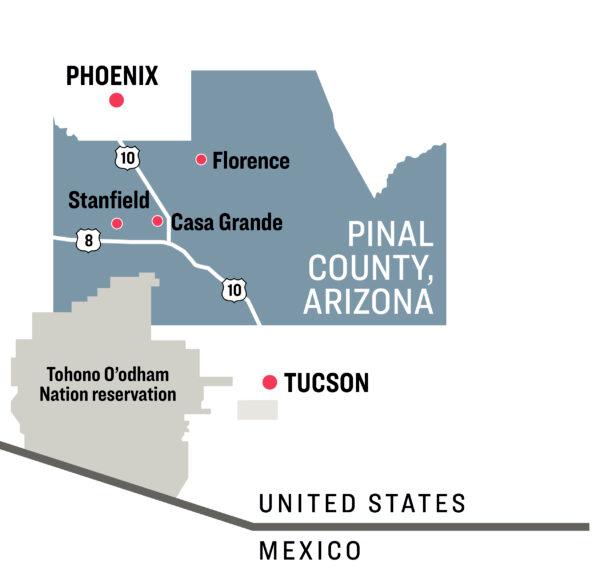
Pinal County and the Indian Reservation
Pinal County is almost 5,400 square miles, about the same size as Connecticut, and its southernmost point sits about 55 miles north of the U.S.–Mexico border.The southwest corner of the county overlaps with the Tohono O’odham Indian Reservation by about 20 miles, but Lamb’s deputies only patrol to the edge of the reservation. Although Border Patrol runs a checkpoint inside the reservation, law enforcement other than tribal police is generally shunned. The Tohono O’odham Nation has its own Constitution and judicial system.
The reservation, which is also about the size of Connecticut, shares 75 miles of largely open border with Mexico, and many of its residents live and travel freely between the two countries. This, along with the harsh and remote Sonoran Desert terrain, makes it a perfect drug-trafficking corridor for cartels.
Drug traffickers also exploit the high levels of unemployment and poverty on reservations, DEA research indicates.
The Tohono O’odham Nation didn’t respond to requests by The Epoch Times for comments about how drug and human smuggling affects the reservation.
Lamb said most of the drugs his deputies seize are within the five-mile stretch where the reservation ends and interstates 8 and 10 converge. I-8 provides a direct link to San Diego, while I-10 goes straight to Phoenix—one of the largest drug trafficking hubs in the country.
The DEA says cartels continue to smuggle “multiple tons of marijuana” through the Tohono O’odham Reservation, as well as cocaine, heroin, and meth.
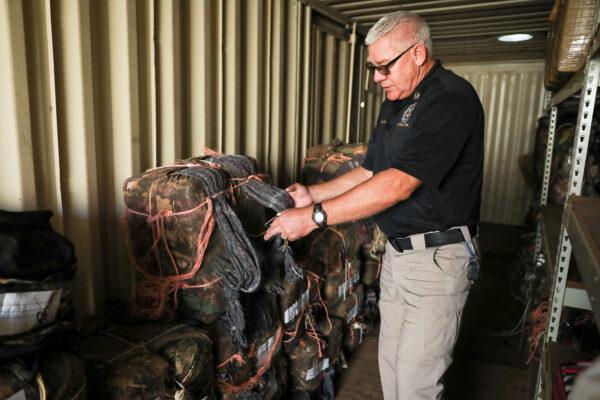
“Methamphetamine continues to be the most prevalent drug seized from drug operations in Indian Country,” the 2018 DEA report states.
In 2018, the last of 18 Mexican cartel affiliates was sentenced for operating a marijuana-smuggling network through the Tohono O’odham Reservation, according to the Justice Department.
The cartel had placed scouts up on high ground inside the United States, who would then guide the marijuana backpacking groups past law enforcement, using radios and cellphones, the Justice Department said.
Co-conspirators would provide the scouts with food, water, binoculars, cellphones, camping equipment, cold and hot weather clothing, and communications equipment.
Although cross-border marijuana seizures are down, Lamb said, “you’re kidding yourself” if you think the cartels have backed down on the marijuana business.
“All we did was make it legal for the cartel to grow it [in the United States] and sell it,” he said. “I would say that 80 percent—and I think a lot of other people would agree—that 80 percent of the legalized marijuana sales here in America—in those states, Colorado, California—are produced and sold by the Mexican cartels.”
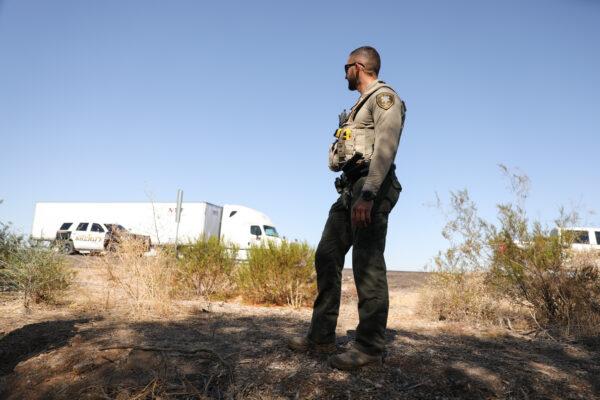
Anti-Smuggling Unit
Lamb’s anti-smuggling unit conducts regular operations to ferret out scouts, as well as to catch illegal aliens and drug smugglers.Sgt. Chris Martin leads the unit of four detectives, two Immigration and Customs Enforcement agents, and one Border Patrol agent. The operations often also include personnel from the Bureau of Land Management and state police. The BLM has an enforcement arm that works to keep the public lands safe and undamaged by smugglers, Martin said.
“We’re really looking to target the organizations that smuggle the contraband and the people,” he told The Epoch Times. “So say we get a group that’s coming through the desert, and we’ve got eyes on them, whether it’s a camera or it’s a team on the high ground, or whatever it is, we generally like to let them load up into a vehicle, because I’m more interested in the driver and the vehicle and the cellphones and the organizations that’s doing that.”
Several months ago, the unit caught a group of illegal aliens after they had loaded up into a waiting truck.
“One of the illegal aliens really started getting agitated and trying to get away from us,” Martin said. They discovered the man was from El Salvador and that he had an arrest warrant in Nevada for child molestation.
“So he really didn’t want to get caught and put back in the system,” Martin said. “There’s a reason why we need to do what we’re doing—that’s not a guy that we want back here.”
He said most of the illegal aliens they catch nowadays are wearing new camouflage clothing, shoes, and large backpacks. He thinks these are provided by the cartels and they’re used as decoys for drug smugglers. If the group is being pursued by law enforcement, the drug smugglers will run off, while the others will give up and get caught.
Last spring, the aliens who surrendered to law enforcement had large backpacks with new sleeping bags in them, Martin said. “Who’s going to carry a sleeping bag for 70 miles when you don’t need one because it’s not cold?” he said.
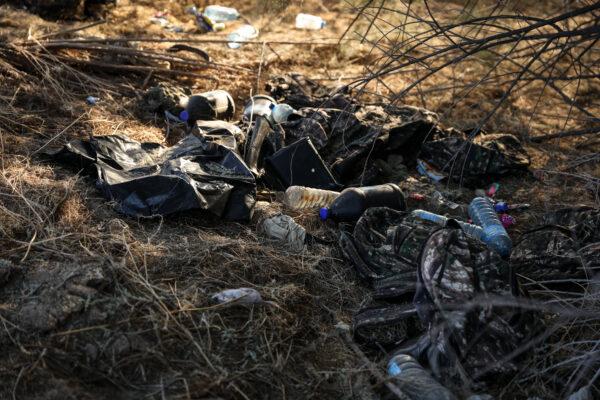
A popular pickup spot is in the Vekol Valley area at mile marker 157 on I-8, which then links to the I-10 to Phoenix at Casa Grande. Illegal aliens and drug smugglers can walk directly from the border, up through the reservation to I-8. The highway is flat and the nearby trees provide some coverage while aliens await their ride. Piles of discarded camo clothing, backpacks, and water bottles are strewn all through the wash near the highway, evidence of the frequent pick-ups made here.
Recent construction on the highway, however, has disrupted the pattern and pushed some of the traffic to different areas, including a local canal.
Another popular pick-up area for smuggling loads is near the Silver Bell Estates, a remote community that also abuts the reservation. Discarded clothing and water bottles are abundant, and fresh tire tracks early one November morning suggest a missed opportunity to catch a smuggler.
“Smuggling loads happen all day long,” said Sheriff’s Deputy Erik Larsen. “For every one that we catch, there’s probably six or seven that go by.”
Larsen said deputies used to see a lot of “‘French fry loads’—where there’s a bunch of people standing up in the back of a pickup or hanging onto a Tahoe.” The smugglers are trying to move aliens and drugs further north as quickly as possible.
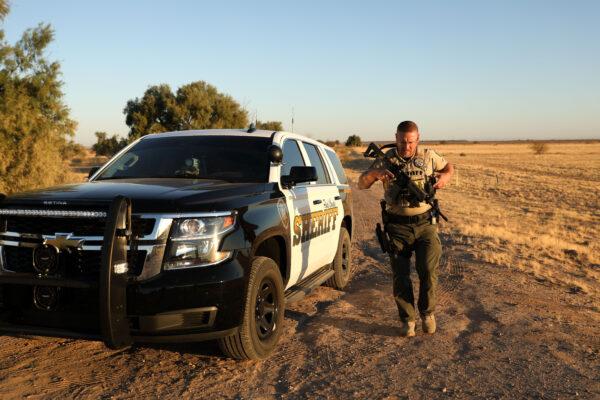
Lamb said all different types of vehicles are used for smuggling, from commercial to personal.
“A truck that we pulled over was full of jalapeños and we found people hidden in the jalapeños, freezing to death,” Lamb said, adding that cocaine and heroin also were found on that shipment.
The smuggling of humans has become just as big for the cartels as drug smuggling, he said.
“We just have a constant flow. I think last week, we had a day where we captured two and nine and seven and four people. It’s nonstop for us,” he said.
“Twenty years ago, 15 years ago, you could come over here on your own, if you knew the route. The cartels own those routes now, so you don’t come across unless you paid the cartel a fee to come across.
“And the cartel uses it as their transportation model. So you pay the cartel to come across and then they make you carry drugs. And they don’t care whether or not you live or die because there’s a gazillion other people waiting to do the same thing.”
Building a border fence that cuts through the reservation along the U.S.–Mexico line is an unlikely and unfeasible scenario, Martin said.
But as the amount of fence increases along either side of the reservation, the reservation corridor will become “more and more valuable to the cartels,” he said.
The solution is to strengthen what they’re currently doing with interdiction efforts along the five-mile band at the edge of the reservation, Martin said.
“And if we’re successful enough at making it hard to get off the reservation with contraband, then they will go somewhere else.”
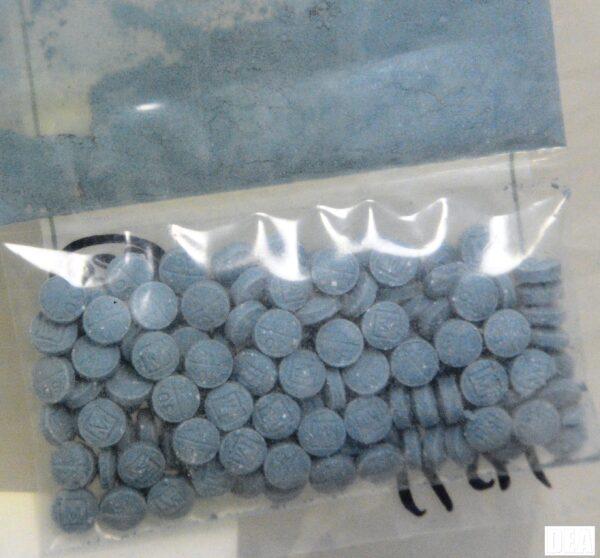
Fentanyl
Aside from meth, illicit fentanyl is being brought into the United States in increasing amounts. Fentanyl, a synthetic opioid, is 100 times more potent than morphine.Fentanyl seizures in Arizona have more than tripled each year since 2016.
More than 1 million fentanyl pills were seized by Arizona law enforcement and the DEA’s Phoenix division during fiscal 2019. About 380,000 were seized in fiscal 2018.
“Mexican cartels began to manufacture their own fentanyl and press the drug into pill form as the primary opioid substance, marketing the pills as ‘Mexican oxy’ to those seeking opiate-based pills on the street,” the 2019 National Drug Threat Assessment from the DEA states.
In the past, fentanyl had mainly been mixed into heroin to boost the high, but now it’s often pressed into small blue tablets and stamped with “M30” to closely match the color and markings of prescription oxycodone pills.
Buyers may be unaware the pills contain fentanyl, of which a 2mg dose can be fatal.
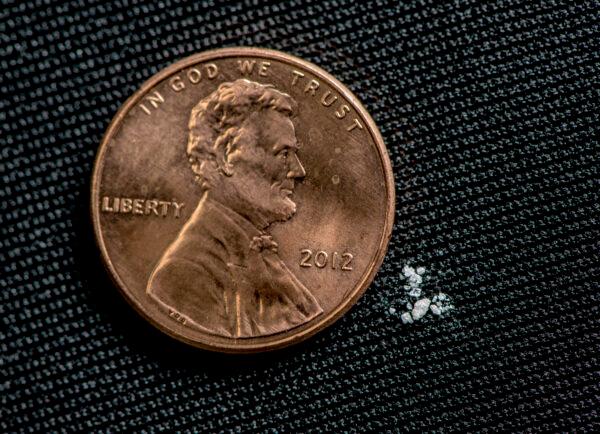
“You’re going to see more and more increase in fentanyl,” said Lamb. “Fentanyl is cheap to produce. It’s very potent. It increases dependability and addiction.”
Lamb said other drugs can easily be laced with fentanyl, including marijuana, “which gets the kids hooked on the drugs a little bit quicker.”
In 2018, the sheriff’s office didn’t seize any powdered fentanyl or M30 pills.
But in 2019, 551 M30 pills were seized, along with nine pounds of powdered fentanyl. Seizures of pure fentanyl pills increased by 75 percent.
“Fentanyl and other highly potent synthetic opioids—primarily sourced from China and Mexico—continue to be the most lethal category of illicit substances misused in the United States,” the 2019 DEA report says.
The volume of fentanyl trafficked from Mexico is high, but the purity is typically low (less than 10 percent pure on average), according to the DEA.
“Conversely, fentanyl trafficked through the mail from China typically arrives in smaller quantities that are highly pure (frequently 90 percent or higher purity),” the DEA report states.
Clandestine fentanyl pill pressing operations are dotted all over the United States, according to the DEA.
“These operations are popular since traffickers can invest in as little as a kilogram of fentanyl powder and produce hundreds of thousands of counterfeit fentanyl-containing pills to generate large amounts of revenue,” the report states.
The use of the dark web and cryptocurrency has made it more difficult for law enforcement to track transactions and communications.
Lamb said wherever a drug market exists in the United States, the cartel has a presence there.
“Because they have to make sure that they can recoup their money for the product that they’ve delivered and sold. They get their money and then, that money starts to flow back towards Mexico,” he said.
The Sinaloa cartel maintains the most expensive footprint in the United States, while the Jalisco New Generation Cartel (Cartel Jalisco Nueva Generación, or CJNG) has become the second-most dominant domestic presence over the past few years, according to the DEA.
On Feb. 20, the DEA announced the launch of Operation Crystal Shield to target eight major methamphetamine transportation hubs—Atlanta, Dallas, El Paso, Houston, Los Angeles, New Orleans, Phoenix, and St. Louis.
These areas accounted for more than 75 percent of methamphetamine seized in the United States in 2019.
The DEA said many opioid addicts are reportedly transitioning to meth, while drug traffickers and dealers are selling meth as counterfeit pills or using methamphetamine as an adulterant.
“The emerging trend of methamphetamine in pill form also targets prescription stimulant users and appeals to non-traditional drug users due to the length of the high and the cheap price of methamphetamine,” the DEA states.
Lamb said the focus needs to be stopping the drugs at the border.
“If you care about humanity, you should absolutely care about border security,” he said. “The drugs that are coming into this country are harming communities, harming our children, our adults, everything.
“Now will they find a different way? Probably. But you can’t raise the white flag. You can’t just give up because you think they’re going to bring it in anyways. You stop them. And if they have to find a more expensive route to bring in their product, then that’s going to increase the cost of drugs, which is inherently going to reduce usage.”
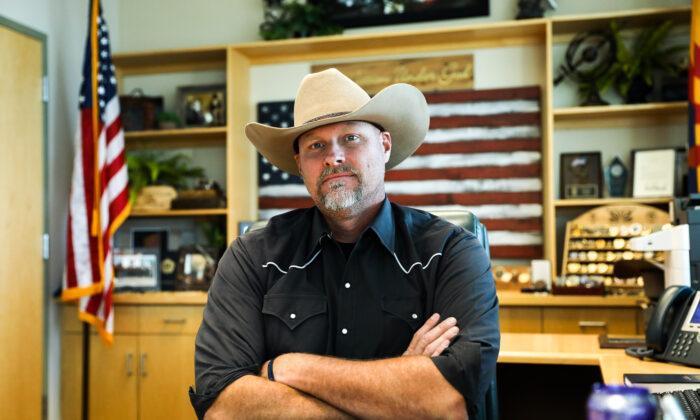



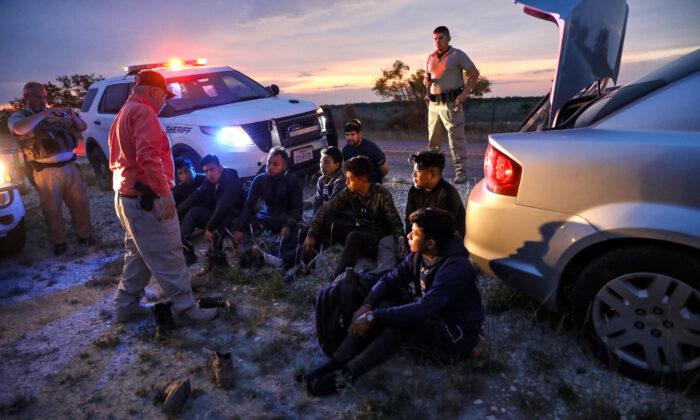
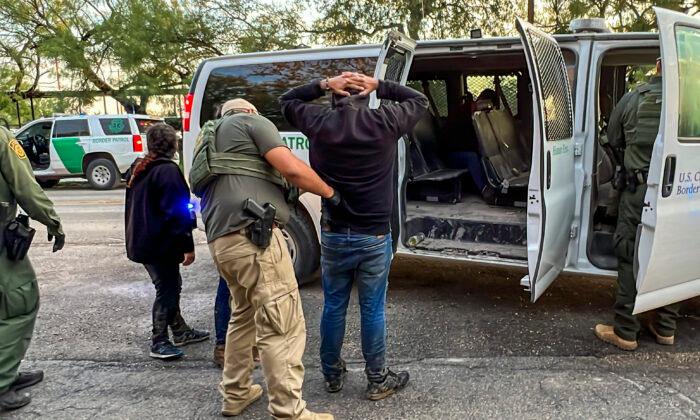
Friends Read Free